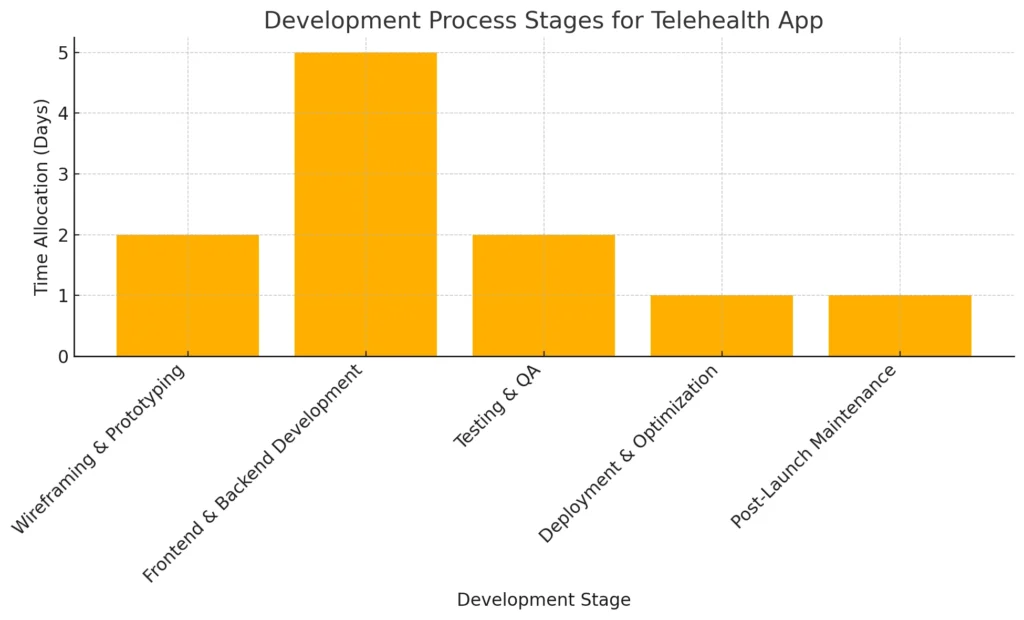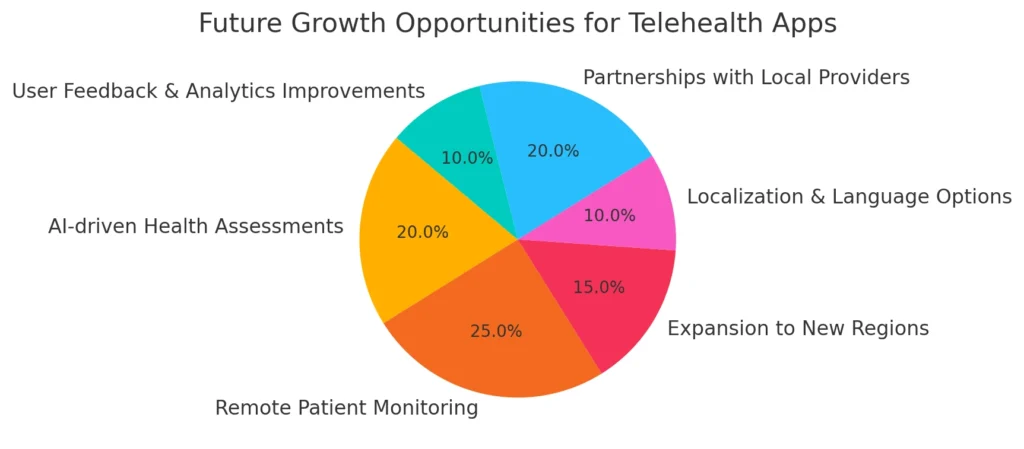In today’s fast-paced world, access to quality healthcare has taken on new urgency, and telehealth apps like Push Doctor are at the forefront of this revolution. These apps connect patients to licensed medical professionals via video consultations, making healthcare accessible anytime and anywhere. With the rise of digital health solutions, developing a Push Doctor-like app can be a game-changer for anyone looking to enter the telemedicine industry.
Les solutions Miracuves simplifies this journey by offering affordable, ready-made app solutions that reduce costs and development time. Imagine launching your telehealth platform in just 10 days and at 10% of the global cost—Miracuves Solutions makes it possible, empowering you to bring quality healthcare to people’s fingertips faster than ever.
What is Push Doctor, and What Does It Do?
Push Doctor is a pioneering telehealth app that allows patients to consult doctors online, making healthcare both accessible and efficient. Founded in the UK, Push Doctor serves as a lifeline for individuals seeking medical advice without needing to visit a clinic. With a few taps, users can book appointments, engage in live video consultations, and even receive electronic prescriptions that can be sent directly to their preferred pharmacy.
In today’s healthcare landscape, apps like Push Doctor are invaluable. They eliminate wait times, reduce the spread of infections in waiting rooms, and provide convenience for both patients and medical professionals. Through features such as 24/7 availability, secure medical record storage, and in-app payment options, Push Doctor has established itself as a reliable and user-centric solution. The demand for such telehealth services continues to grow, making it an ideal model for anyone considering a similar venture.
| Fonctionnalité | Push Doctor | Teladoc | Médecin à la demande | Amwell |
|---|---|---|---|---|
| Video Consultations | Oui | Oui | Oui | Oui |
| 24/7 Availability | Oui | Oui | Oui | Oui |
| Electronic Prescriptions | Oui | Oui | Oui | Oui |
| Prise de rendez-vous | Oui | Oui | Oui | Oui |
| In-App Payment Options | Oui | Oui | Oui | Oui |
| Medical Record Storage | Oui | Oui | Oui | Oui |
| Specialist Consultation | Limité | Oui | Oui | Oui |
| Intégration des assurances | Non | Oui | Oui | Oui |
Pourquoi créer cette application ?
Building a telehealth app like Push Doctor isn’t just about tapping into a booming industry; it’s about making healthcare accessible to everyone, everywhere. Telemedicine has become a preferred method for consultations, as people increasingly seek convenient healthcare solutions that fit into their busy lives. By developing an app with similar capabilities, you’re not only meeting this demand but also filling vital gaps in traditional healthcare services.
Investing in telehealth app development can be a game-changer, but the cost often becomes a barrier. Here’s where Les solutions Miracuves steps in. With development costs that are only 10% of the global standard and a timeline that reduces months of work to just 10 days, Miracuves Solutions makes it possible to bring high-quality telehealth services to market quickly and affordably. This cost-efficiency, combined with rapid deployment, allows you to focus on what truly matters—building a service that helps people manage their health, without breaking the bank.
| Stade de développement | Estimation des coûts globaux | Coût des solutions Miracuves |
|---|---|---|
| Conception et prototypage | $1,000 | $100 |
| Développement Frontend et Backend | $3,000 | $300 |
| Tests et assurance qualité | $1,000 | $100 |
| Deployment and Maintenance | $1,000 | $100 |
| Coût total estimé | $6,000 | $600 |
Comment différencier votre application des autres

In the competitive telehealth market, setting your app apart from others is crucial. While core features like video consultations and electronic prescriptions are essential, adding unique elements can make your app stand out. Think about integrating AI-powered health assessments, which can guide users through initial symptom-checking before they speak to a doctor. Another option could be advanced personalization, like sending reminders for check-ups or creating health progress tracking.
Partnering with specialized medical providers can also enhance your app. By offering unique consultations—such as mental health, nutrition, or physiotherapy—you attract a broader audience and give users more reasons to choose your platform. Making the app more accessible, such as offering multilingual support or integrating with local insurance providers, will further elevate its appeal.
Taille du marché, croissance, chiffre d'affaires et modèle économique
| Région | Market Size (2023) | Taille du marché projetée (2027) | Taux de croissance (%) |
|---|---|---|---|
| Amérique du Nord | $105 billion | $210 billion | 20% |
| Europe | $68 milliards | $130 billion | 15% |
| Asie-Pacifique | $52 billion | $135 billion | 25% |
| l'Amérique latine | $20 billion | $45 billion | 18% |
| Middle East & Africa | $15 milliards | $39 billion | 22% |
The telehealth industry has seen unprecedented growth, with the global market size projected to exceed $559 billion by 2027. Factors like rising healthcare costs, patient demand for convenient access, and advancements in digital health technology continue to fuel this expansion. Building an app like Push Doctor taps into this flourishing market, allowing you to reach an audience that values quick, on-demand healthcare.
For monetization, telehealth apps use diverse models, including subscription plans, pay-per-visit fees, and partnerships with healthcare providers. Subscriptions can secure regular revenue, while per-visit fees offer flexibility for users who may not need frequent consultations. Additionally, collaborations with hospitals and insurance providers can boost credibility and attract more users. With a carefully planned business model, a telehealth app has the potential to become a stable and lucrative venture.
Features of Push Doctor and Similar Apps
To create a robust telehealth app like Push Doctor, you’ll need a comprehensive set of features that meet both patient and provider needs. Core functionalities such as video consultations et appointment scheduling form the backbone of any telehealth service. Video consultations allow real-time doctor-patient interactions, bridging the gap between virtual and in-person visits, while appointment scheduling ensures smooth and flexible booking experiences for users.
Additional features like electronic prescriptions enable doctors to send prescriptions directly to patients’ preferred pharmacies, saving them time and hassle. Another valuable addition is medical record storage, where patients can securely access their health history within the app, allowing for a more personalized healthcare experience. In-app payment options provide convenience, letting users pay for services instantly and securely.
Introducing a Produit minimum viable (PMV) with these essential features can allow you to launch quickly and test the market before adding more complex functionalities. By focusing on these core features, you’re setting a solid foundation for a successful telehealth platform.
Exigences techniques

Creating a telehealth app requires a well-chosen technology stack to ensure seamless functionality, security, and scalability. At the core of any telehealth platform is a robust backend that can handle high volumes of data securely and efficiently. This typically involves cloud storage solutions like AWS or Google Cloud, which provide the flexibility to scale as the app grows while ensuring data is always accessible and protected.
For video consultations, integrating a reliable API like WebRTC or Twilio is essential. These technologies allow smooth, high-quality video calls, replicating the experience of an in-person consultation. Data encryption is also non-negotiable in telehealth to maintain HIPAA compliance and protect sensitive patient information.
Other requirements include a user-friendly frontend framework like React Native, which supports a smooth experience across both iOS and Android. Finally, tools like Firebase or Mixpanel can be invaluable for tracking user behavior, providing insights that will help in refining the app over time. Together, these technologies form the foundation of a secure, scalable, and responsive telehealth app.
A robust backend, using cloud solutions like Google Cloud, is essential for handling data securely and efficiently.
Conception et interface utilisateur (UI/UX)
In telehealth, the design and user experience are critical to ensuring that patients feel comfortable navigating the app. For both first-time users and regular patients, a clear, welcoming interface is key to a positive experience. Designing for simplicity—such as using intuitive icons, minimal text, and an organized layout—helps users easily find what they need, whether that’s booking an appointment, joining a video call, or accessing their medical history.
For patients, the app should prioritize accessibility. Features like larger fonts, contrasting colors, and user-friendly buttons make the app more inclusive, especially for older users or those with visual impairments. Additionally, for doctors and healthcare providers, the interface should enable quick access to patient information and offer smooth navigation between appointments and consultation notes.
Creating a consistent and calming color scheme can also help establish trust. Blues and greens, for instance, are often used in healthcare settings to create a sense of reliability and calmness. With thoughtful design and a smooth user experience, your telehealth app can be both highly functional and inviting, helping users feel more at ease with virtual healthcare.
Processus de développement

Building a telehealth app requires a structured development process to ensure every feature is functional, user-friendly, and secure. The journey typically starts with wireframing and prototyping, where developers outline the app’s basic structure and flow. This step is crucial for visualizing how each part of the app will work together and allows for early feedback on the design and user experience.
Once the prototype is approved, the team moves to frontend and backend development. This stage is where core functionalities, like video consultations, appointment scheduling, and electronic prescriptions, come to life. Integrating APIs for video calls, ensuring data encryption, and establishing the database are all essential parts of this phase. At this point, the app is built to meet telehealth compliance standards, like HIPAA.
The next step is testing and quality assurance (QA). Here, the app undergoes rigorous testing to identify any issues, from video lag during consultations to bugs in scheduling. Functional testing, security checks, and user experience reviews help to ensure a smooth launch.
Finally, the app is ready for déploiement, where it’s optimized for iOS and Android, and prepped for app store submission. Post-launch, regular maintenance and updates will be necessary to keep the app running smoothly, add new features, and keep up with user feedback.
Estimation des coûts et délais
Estimating the cost and timeframe for building a telehealth app depends on several factors, such as the complexity of features, the technology stack, and the development process. On a global scale, creating a full-scale telehealth app can cost anywhere from $6,000 to $50,000, depending on the scope. However, Les solutions Miracuves provides a more affordable and streamlined approach, offering ready-made solutions at 10% of the global cost. For example, instead of $6,000, a comparable app from Miracuves Solutions can be delivered for just $600.
The timeframe for developing an app also varies, with traditional models often taking around a month or more. Miracuves Solutions, however, can complete the app in as little as 10 days, ensuring quick entry into the market. This shortened timeline allows for faster user acquisition and an immediate return on investment, giving you a significant edge in a competitive industry.
| Development Aspect | Global Average | Les solutions Miracuves |
|---|---|---|
| Coût total | $6,000 – $50,000 | $600 |
| Laps de temps | 1 month or more | 10 jours |
| Design & Prototyping Cost | $1,000 | $100 |
| Coût de développement | $3,000 | $300 |
| Testing & QA Cost | $1,000 | $100 |
| Deployment Cost | $1,000 | $100 |
Stratégies de monétisation
Monetizing a telehealth app opens doors to various revenue streams, making it a profitable venture. One popular approach is formules d'abonnement, where users pay a monthly or annual fee for unlimited access to consultations. This model offers steady, predictable revenue and appeals to users who need regular medical support. Alternatively, a pay-per-visit model allows patients to pay only when they need a consultation, giving them flexibility and catering to those who might not require frequent services.
Another effective option is in-app advertising, where health-related brands can advertise directly to app users. This is particularly beneficial for free or low-cost apps, generating revenue without requiring a direct charge for healthcare services. Additionally, collaborations with insurance companies can provide coverage for consultations, increasing the app’s appeal while also providing a revenue-sharing opportunity.
These monetization strategies offer multiple ways to generate revenue, allowing you to create a financially sustainable telehealth app that meets user needs and business goals.
Lancement et commercialisation de l'application
Launching a telehealth app successfully requires more than just a feature-complete product—it needs a strong marketing strategy to attract users and drive downloads. The first step is Optimisation de l'App Store (ASO), where you fine-tune the app’s description, keywords, and visuals to improve its ranking in app stores. Choosing keywords related to telehealth, virtual care, and online doctor consultations can help potential users discover your app easily.
To build credibility and trust, consider collaborating with healthcare influencers or professionals who can endorse your app. Having well-known medical professionals or influencers share your app on social media can boost its visibility. Additionally, investing in publicités ciblées on platforms like Google, Facebook, and Instagram can drive awareness, focusing on audiences who are actively seeking healthcare solutions.
After launch, offering introductory offers or discounts for new users can encourage sign-ups and increase user retention. Providing these initial incentives helps establish a user base, creating momentum for future growth. Consistent marketing efforts and a strategic launch plan will ensure your telehealth app gains the traction needed to succeed in a competitive market.
Considérations juridiques et réglementaires
In telehealth, adhering to legal and regulatory standards is essential to maintain user trust and avoid hefty fines. A major requirement is HIPAA compliance (Health Insurance Portability and Accountability Act) in the U.S., which mandates secure handling of sensitive patient data. Ensuring that all data storage, transmission, and access are encrypted is crucial for HIPAA compliance, helping to safeguard patients’ privacy. Similar regulations, such as GDPR in Europe, apply strict rules around data protection, making it necessary for telehealth apps to comply with these standards globally.
User consent is another important aspect. Before any consultation or data collection, the app should prompt users to accept terms and conditions, ensuring that they are informed about data handling practices. Clear terms of service and privacy policies outline the app’s responsibilities and help prevent legal issues down the line. Additionally, telehealth apps should comply with app store guidelines for healthcare apps, ensuring smooth approval and accessibility to users.
Incorporating these legal safeguards establishes credibility, reduces risk, and enhances user confidence in your telehealth app.
Ensuring that all data storage, transmission, and access are encrypted is crucial for HIPAA compliance standards, helping to safeguard patients’ privacy.
Croissance future de l'application

A well-designed telehealth app has ample room for growth, especially as the demand for virtual healthcare continues to rise. As user needs evolve, adding features such as AI-driven health assessments ou remote patient monitoring can enhance the app’s value and keep it relevant. These advanced features allow patients to track vital signs, receive personalized health insights, and connect with healthcare providers more proactively, positioning the app as a comprehensive health tool rather than just a consultation platform.
Expanding into new regions can also fuel growth, especially in areas where healthcare access is limited. By localizing content, offering language options, and adjusting to region-specific healthcare standards, the app can cater to a broader audience. Partnering with local healthcare providers and insurance companies can further strengthen the app’s presence and reputation, opening doors to larger, more diverse user bases.
Finally, keeping an eye on user feedback and app analytics is vital for future improvements. Listening to what users want—whether it’s quicker appointment scheduling, additional specialties, or new consultation options—will ensure that the app continues to meet market needs. With these strategies, your telehealth app can grow sustainably and maintain its competitive edge in a fast-evolving industry.
Pourquoi faire confiance aux solutions Miracuves pour votre prochain projet ?
Choosing the right development partner can make or break the success of your telehealth app, and Les solutions Miracuves stands out as a reliable choice. With extensive experience in building ready-made solutions, Miracuves Solutions offers a unique advantage: high-quality app development at just 10% of the typical global cost, with delivery timelines shortened from weeks to a matter of days. This efficiency allows you to launch sooner and start reaching users without the usual financial and time constraints.
Miracuves Solutions also prioritizes customization, enabling you to add or modify features to meet your specific needs. Whether it’s integrating advanced security protocols, scaling up the app as it grows, or offering continuous post-launch support, Miracuves Solutions provides a robust framework for telehealth app development. With their ready-made solutions, you’re not just saving time and money; you’re partnering with a team dedicated to helping your app succeed in a competitive market.
Conclusion
Building a telehealth app like Push Doctor offers a rewarding opportunity to enter a rapidly growing market while providing valuable healthcare access to users. By focusing on essential features, securing a robust tech stack, and adhering to regulatory standards, you can create an app that meets both industry demands and user expectations. With Les solutions Miracuves, this journey becomes simpler, faster, and more cost-effective, allowing you to launch an app that competes effectively without the usual financial hurdles.
Whether you’re adding unique features, expanding into new markets, or prioritizing patient-centered design, this telehealth app can be a pivotal step in advancing digital healthcare. Ready to make a meaningful impact? With the right approach, your app can bridge healthcare gaps and offer convenient, accessible services to patients everywhere.
FAQ
How much does it cost to build a telehealth app with Miracuves Solutions?
With Miracuves Solutions, a telehealth app can be developed at 10% of the global cost, making it as affordable as $600 for a full solution.
How quickly can I launch my app with Miracuves Solutions?
Miracuves Solutions can deliver a ready-made telehealth app within 10 days, significantly faster than the typical industry timeline of one month.
What customization options are available in ready-made solutions?
Miracuves Solutions allows you to customize features like video consultations, appointment scheduling, and even advanced integrations, adapting to specific business needs.
Do Miracuves Solutions’ apps comply with industry regulations?
Yes, all telehealth apps built by Miracuves Solutions are designed to comply with industry standards such as HIPAA, ensuring secure and private data handling.
Is post-launch support included with Miracuves Solutions?
Miracuves Solutions offers continuous support and maintenance, assisting with updates, performance monitoring, and feature enhancements post-launch.





























































